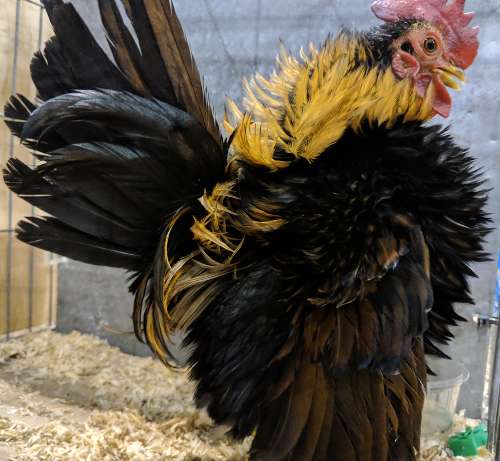Pekin Bantam colours and patterns.
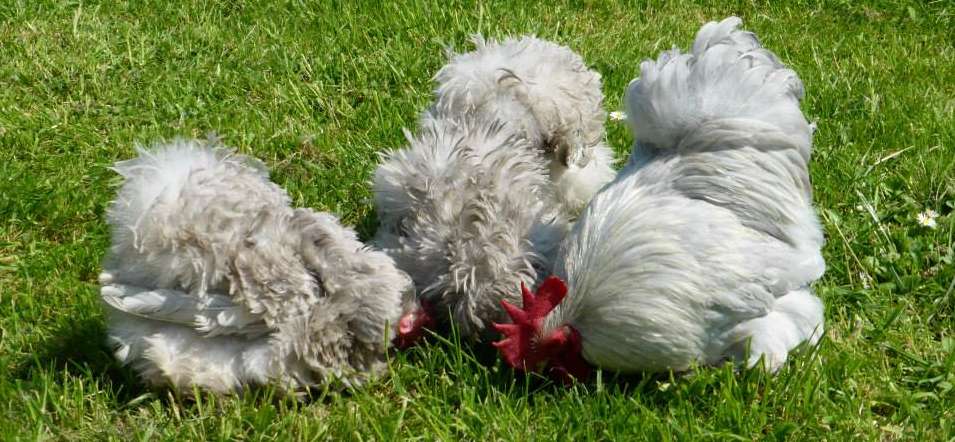
The range of Pekin colours is extensive, and the list is continually growing. Various combinations are available as well produced by cross-breeding. Not all colours and feather patterns are in all the standards.
Colours of Pekin bantams include: (click the colour to skip down the page).
Table of Contents
- Pekin chickens colour types and feathering:
- Black Pekin Bantam chicken:
- White Pekin Bantam:
- The Blue Pekin Bantam:
- The Red Pekin Bantam:
- Lavender Pekins:
- Buff Pekin chickens:
- Cuckoo Pekins:
- The Gold Partridge Pekin Bantam:
- The Silver Partridge Pekin Bantam:
- Birchen Pekin:
- The Brown Red Pekin:
- The Mottled Pekin Bantam:
- The Barred Pekin:
- The Columbian Pekin Bantam:
- Coronation Pekin Bantams:
- Silver Laced Pekin :
- Gold Laced Pekin Bantams:
- Millefluer Pekins:
- Splash feathered Pekins:
- Porcelain Pekin chickens:
- Chocolate Pekins:
- Wheaton Pekins:
- Salmon pekins:
- Frizzle feathered pekins:
Rarer colours are in great demand, and many breeders spend much time perfecting new lines of colours in their birds. Frizzled Pekins are common.
In both sexes and all colours the beak must be yellow, but in dark colours may be shaded with black or horn. Eyes red, orange or yellow-red preferred. Comb, face, wattles and ear-lobes bright red. Legs and feet yellow. (Dark legs permissible in blacks if the soles of the feet and back of shanks are yellow).
Pekin chickens colour types and feathering:
They can have straight (normal) feathering or frizzle feathering, which means that the feathers grow the opposite way round and stick out rather than running smooth, giving them a fluffy appearance.
All types of Pekins have short, feathered legs and feather covered feet and toes. The hens have a rounded full and bushy tail called a bustle which gives them the rounded, puffed up appearance.
The abundance of feathering does give the Pekin the appearance of being larger and heavier than they actually are, but their average weight is only 680 g (24 oz) for males and 570 g (20 oz) for females.
The have short shanks and are small round, fluffy and tilted. The feather makes them look much bigger than they actually are. the roundness, the tilt foreword and the cushion were
They are rather round-shaped, and their carriage tilts forward, with the head slightly closer to the ground than their elaborate tail feathers. This 'tilt' is a key characteristic of the Pekin. The bird on the whole, though the tail especially, should be abundantly feathered, and well rounded.
Black Pekin Bantam chicken:
Male and female plumage should be a rich sound black with lustrous beetle-green sheen throughout, free of white or coloured feathers.
Below: A black pekin bantam cockerel.
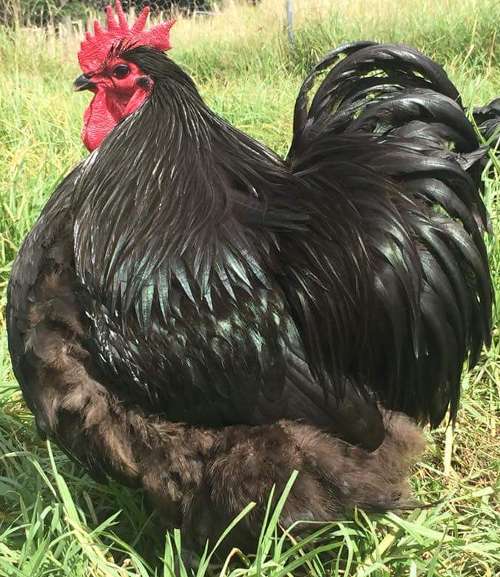
You should select birds for ground colour which must be glossy greenish black.
Below: A black Pekin hen.
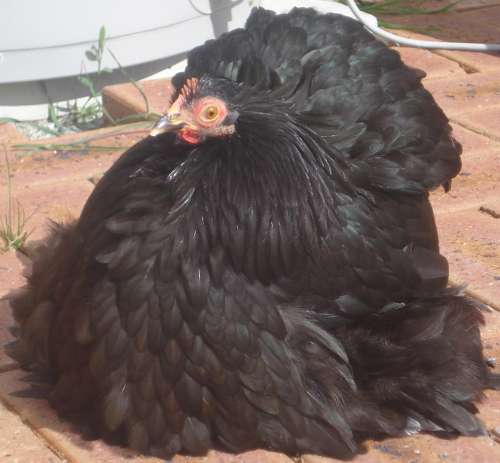
The feather colour should be as even as possible.
White Pekin Bantam:
Male and female plumage should be pure snow-white, free from cream or yellow tinge, or black splashes or peppering.
Below: A white Pekin hen.
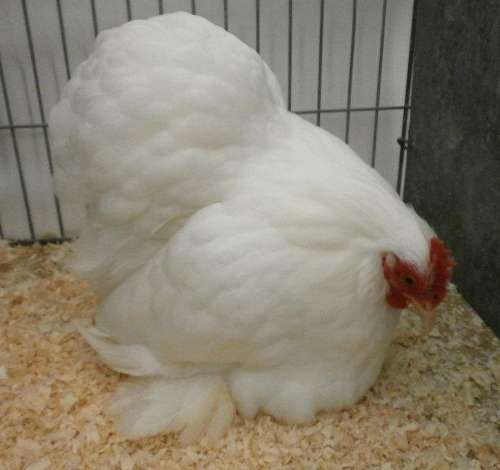
Below: A white Pekin bantam cockerel.
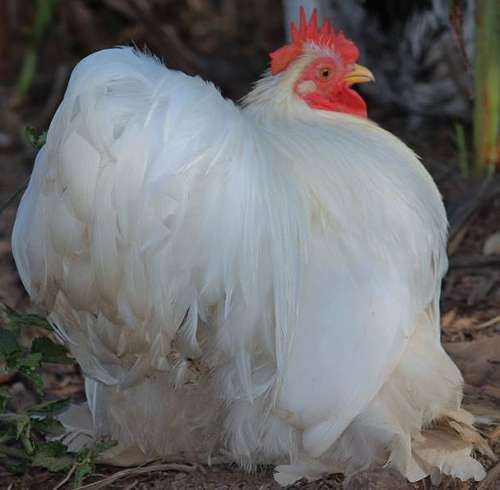
The Blue Pekin Bantam:
Both male and female plumage should be a rich pale blue (Pigeon blue preferred) free from lacing, but with rich dark blue hackles, back and tail in male.
Below: A blue Pekin cockerel.
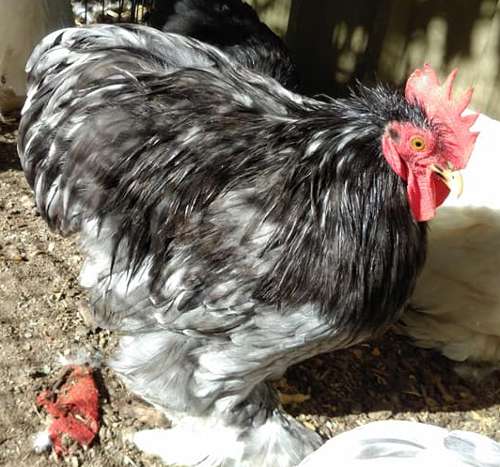
Below: A blue pekin bantam hen.
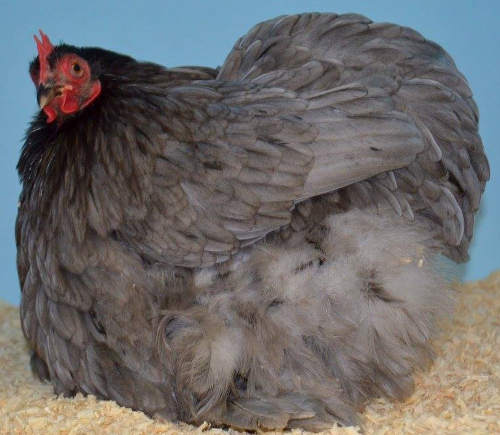
The Red Pekin Bantam:
The tail should be of almost equal height with the top of the comb and very full and round. Legs and feet should be profusely feathered, preferably without vulture hocks.
Below: The red Pekin bantam cockerel.
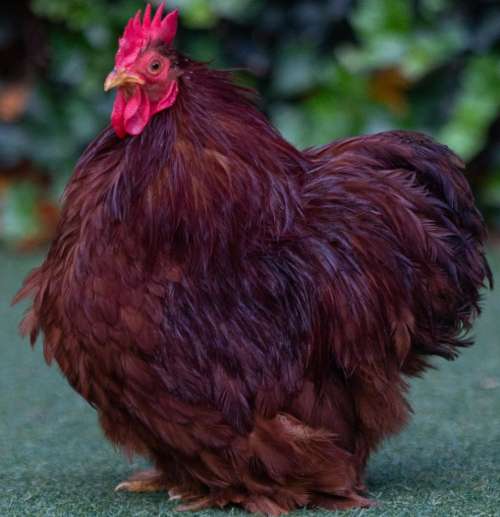
Below: A red Pekin hen.
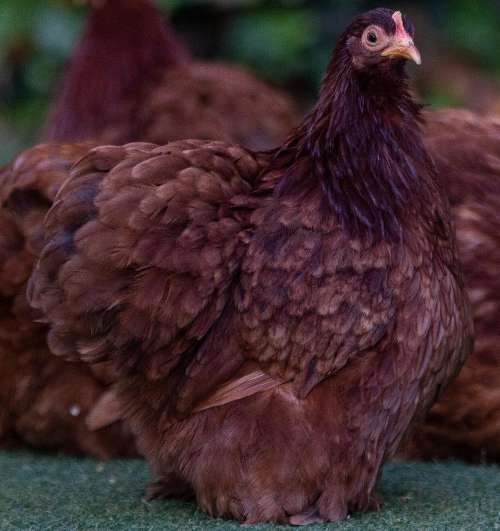
Pekin have a single, red comb, yellow beak and legs and red, orange or yellow eyes.
Lavender Pekins:
Lavender is a recessive colour gene meaning that a bird can be carrying the colour but not showing it because to have the lavender colouration a bird must have two sets of the gene, one from the father and one from the mother.
This means if you mate a pure lavender bird to a pure black bird, the chicks will only be black but if you mate a chick back to its lavender parent you will in theory get 50% lavender or 2 chicks out of every 4.
Below: A trio of lavender Pekin.
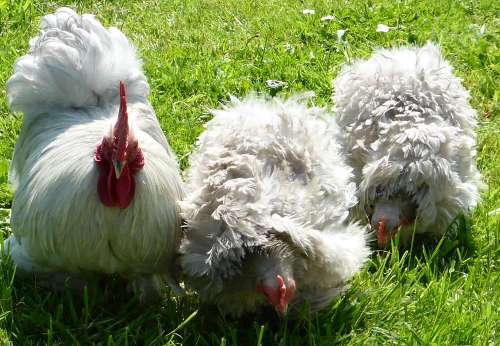
If you mate brother sister of the original mating one will get, in theory, 25% lavender or 1 in 4 chicks. Both parents must have the lavender gene to get a lavender chick.
Most important to remember is that the bird with only one lavender gene cannot be identified unless it is mated to a bird that carries that gene and enough chickens are produced to cover aberrations in the above colour ratios.
Lavender behaves as the colour black does. Where there is black in colour patterns it can be replaced with lavender, for example the coronation Sussex.
Lavender mated to lavender will give only lavender. Apart from slight shade variations all chicks are the same colour, lavender.
Below: Day old lavender Pekin chicks.
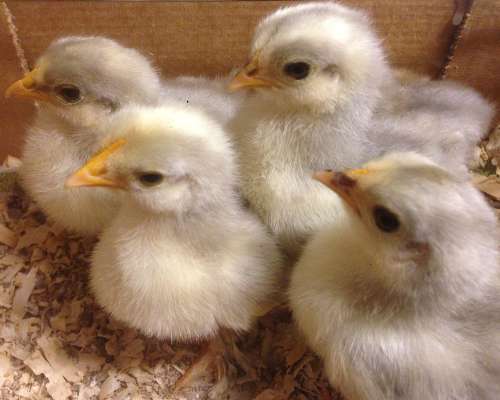
With both the male and female plumage, the lavender is not a lighter shade of the blue Pekin. It is different genetically and is of a lighter more silver tint without the darker shade associated with the normal blue. The silver that is most obvious in the neck and saddle hackle feathers of the male.
Buff Pekin chickens:
Real and true buff is a very soft colour, and a rather light colour in actual shade. For buff feathering, the colour is described as a golden buff.
Male and female plumage: Sound buff, of a perfectly even shade throughout, quite sound to roots of feathers, and free from black, white or bronze feathers.
Below: A buff Pekin cockerel.
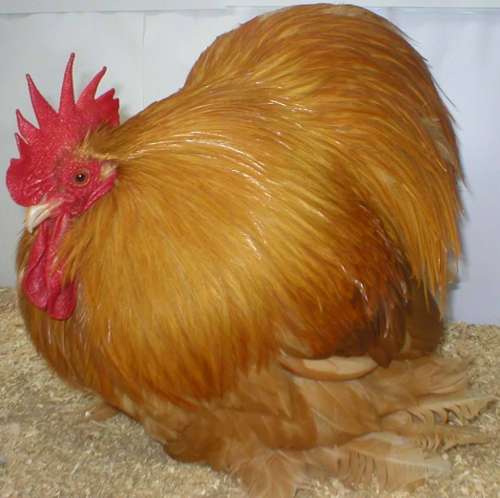
Below: A buff pekin hen.

The exact shade of buff is not material so long as it is level throughout and free from shaftiness, mealiness or lacing. (Note: A pale ‘lemon buff’ is usually preferred in the show-pen).
Cuckoo Pekins:
Both the male and female plumage of the Cuckoo should be evenly banded with dark slate on light French grey ground colour. These points vary very considerably from a pale, almost white ground, with cloudy and indistinct markings, to a beautiful soft French grey ground, with dark slate bars.
Below: The cuckoo Pekin bantam cockerel.

The more clearly defined, and the finer the markings, the better. Not only does the ground colour vary, as well as the colour of the bars, or markings of the feathers, but also in different birds the pattern of the markings varies considerably.
The marking we require in Cuckoo Pekins is a series of clearly defined bars, and I prefer narrow ones, across each feather, from the head, down the hackle, breast, thighs, wing, back, saddle and tail, and, in fact, each feather throughout the whole bird, both cock and hen, must have this distinct barring, or series of bands, across the feathers.
Below: A cuckoo Pekin hen.

In some birds, we have counted nine bars across the hackle or saddle feather of a cockerel, but seven bars make the feather look well. A less number would not be so good. In hens, across the saddle feathers, five bars are sufficient, and as the feathers on other parts of the body are not so long, a proportionately less number of bars are required. The same description of marking is required on the feathering of the legs, feet, and toes, and the more distinct the better.
A common failing of Cuckoos is to have some of the wing feathers white, or with a good deal of white in them, and also in the tail feathers. This is a grave fault, and is reproduced in the chickens most persistently.
The Gold Partridge Pekin Bantam:
Partridge Pekin Bantams are quite a recent production, and, as mentioned previously, our first was the result of a cross between a Black and a Buff. This was, however, much too dark in his hackle and saddle, and the feathers were almost plain red, instead of gold, striped with black.
Below: A partridge Pekin cockerel.
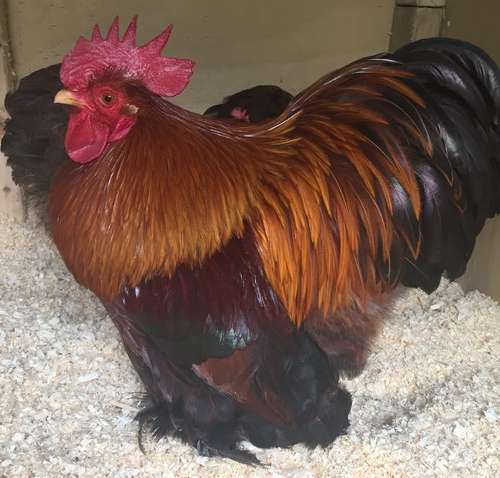
Male plumage: Head dark orange-red, neck hackle bright orange or golden-red, becoming lighter towards the shoulders and preferably shading off as near lemon colour as possible, each feather distinctly striped down the middle with black, and free from shaftiness, black tipping or black fringe.
Saddle hackle to resemble neck hackle as nearly as possible, Breast, thighs, underparts, tail, covert, wing butts and foot feather, hock feather and fluff lustrous green-black, free from grey, rust or white. Back, shoulder covert and wing bow rich crimson. Primaries black, free from white or grizzle, secondaries black inner web, bay outer, showing a distinct wing bay when closed.
Below: Partridge Pekin hens and rooster.
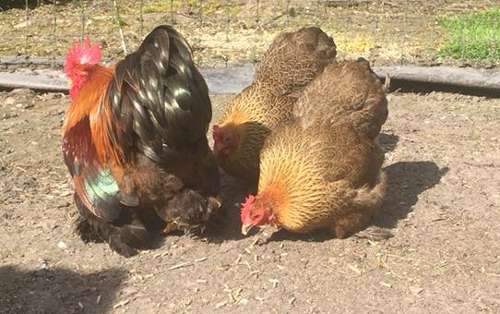
Female plumage: Head and neck hackle light gold or straw, each feather distinctly striped down middle with black. Remainder clear light partridge brown, finely and evenly pencilled all over with concentric rings of dark shade (preferably glossy green-black).
The whole of uniform shade and marking, and the ground colour of the soft brown shade frequently described as the colour of a dead oak leaf, with three concentric rings of pencilling or more over as much of the plumage as possible.
The Silver Partridge Pekin Bantam:
Male Plumage: Head silver-white, neck hackle silver-white, each feather distinctly striped with black and free from shaftiness, black tipping or black fringe. Saddle hackle to resemble neck hackle as nearly as possible.
Below: A silver Partridge Pekin cockerel.
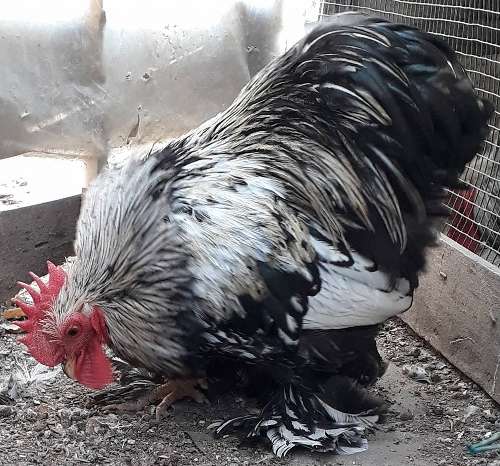
Breast, underparts, tail covert, wing butts and foot feather, hock feather and fluff, lustrous green black, free from grey or white. Back, shoulder covert and wing bow black. Primaries black, free from grizzle; Secondaries – black inner web, white outer, showing a distinct wing bay when closed.
Female plumage: Head and neck silver white, each feather distinctly striped down the middle with black. Remainder silver grey, finely and evenly pencilled all over with concentric rings of dark shade, (preferably glossy green-black).
Below: Silver partridge Pekin hen.

The whole of uniform shade and markings with three concentric rings of pencilling or more, over as much of plumage as possible.
Birchen Pekin:
The birchen is a sort of reverse Colombian pattern.
Male plumage: Hackle, back, saddle, shoulder covert and wing bows silver white, the neck hackle with narrow black striping.
Below: Male birchen Pekin cockerel.
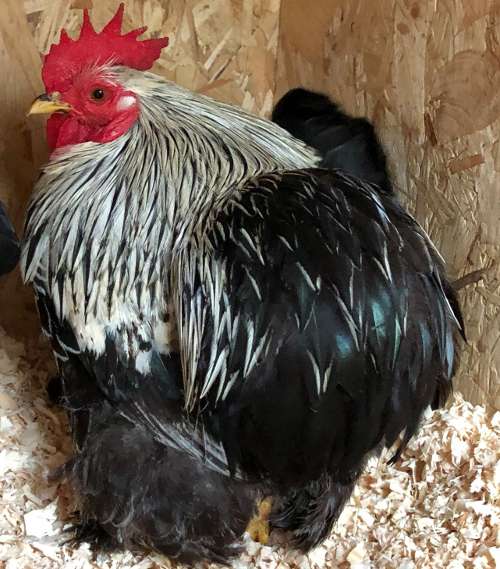
Remainder rich black, the breast having a narrow silver margin around each feather, giving it a regular laced appearance gradually diminishing to perfect black thighs.
Below: Two birchen Pekin hens.

Female plumage: Hackle similar to that of the male. Remainder rich black, the breast very delicately laced as in the male.
The Brown Red Pekin:
The brown red Pekin when bred and shown to its standard colour perfection is undoubtedly one of the most striking coloured of the Pekins on the show bench today.
The combination of a gloss green ground colour on the chest ,body, footings and tail, over- laid by brilliant lemon on the hackles, backs and wing bows is required.
Below: The brown red Pekin hen.
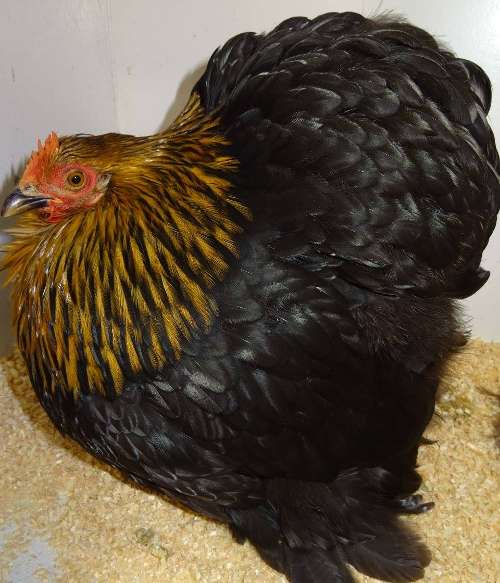
In both male and female, the neck hackle is striped with black, which enhances the overall appearance. In both Male and female the striking contrast of finely lemon-laced chest feathering against a green-black ground colour completes a very attractive bird.
The females shoulders and backs should be free of all colour including ,edging or shafting other than glossy black, as opposed to the males lemon back & shoulder colour.
Below: Brown red Pekin cockerel.
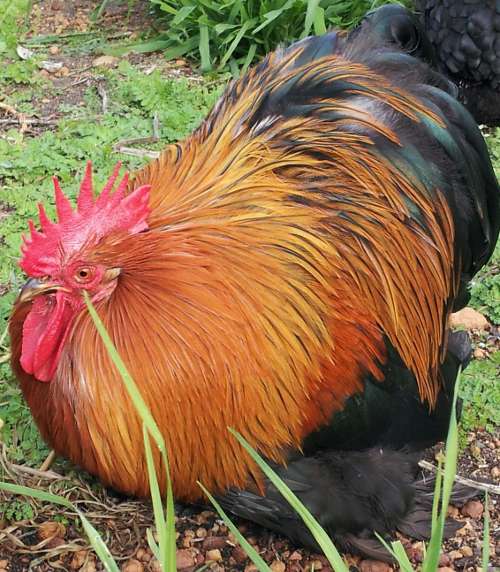
The top- colour of the males however is never as light as the breast lacing be, however the desired specimen must not have back, wing bow, shoulders and covert a deeper shade as is seen in Black reds.
The Mottled Pekin Bantam:
Male and female plumage: Evenly mottled with white at the tip of each feather on a rich black with beetle-green sheen. The Mottle Pekin would be by far one of the most charming of the Pekin colours, particularly with its overall colour contrast of stark white V tipping on a glossy greenish - black ground colour.
Below: A first place prize winning mottled Pekin cockerel.
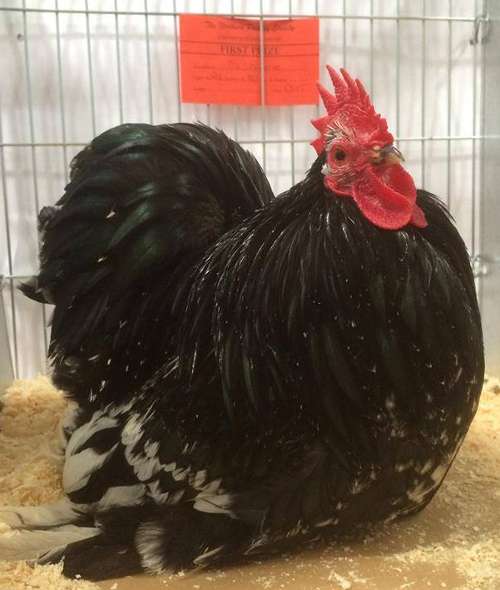
Mottles appeared on the show bench around after considerable work having gone into their making Very few people have had the patience to persevere with the Mottle due to the requirement of the clarity, shape and evenness of the white markings and the intricacies involved in maintaining the required colour.
Below: A mottled Pekin bantam hen with three chicks.
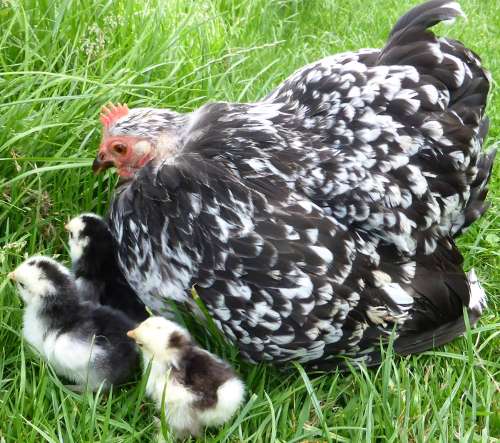
Mottle colour faults: Distinct white splashing rather than tipping on the Neck hackles, saddle hackles, and cushion Irregular splashing of white on the body rather than tips on the feathers No distinction of white between the black the white tip - ie white tips smeared or streaked with black. Full white wing and foot feathers or the appearance is that of a speckled or splashed fowl rather than a mottled fowl.
Faulty blobs of white not correct tipping, faulty body colouring, smeared feathers black neck Female showing neck flashes not correct tipping or incorrect wing colour.
The Barred Pekin:
Male and female plumage: Each feather barred across with black bars, having a beetle-green sheen on a white background. The barring to be equal proportions of black and white.
Below: A barred Peking cockerel.
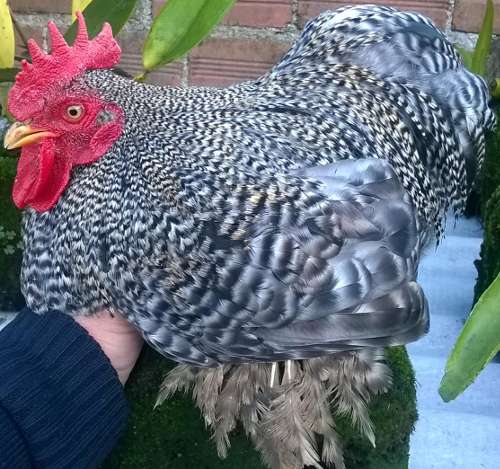
The colours to be sharply defined and not blurred or shaded off.
Below: Barred Pekin hens. Notice how clean and distinct the barring is and how straight the lines on the feathers are.
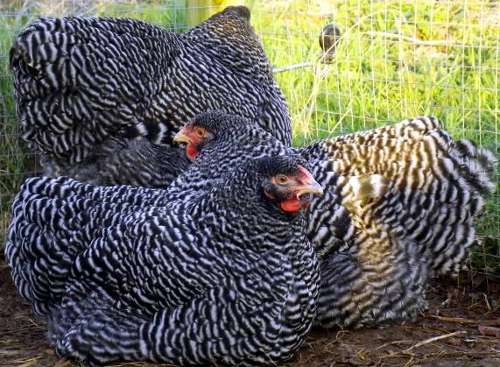
Barring should continue through the shaft and into the under fluff, and each feather must finish with a black tip. Plumage should present a bluish, steely appearance free from brassiness and of a uniform shade throughout.
The Colombian Pekin Bantam:
The plumage of both the male and female should be pearl-white with black markings. Head and neck white with dense black stripe down middle of each feather, free from black edgings or black tips.
Below: A trio of Colombian Pekin bantams.
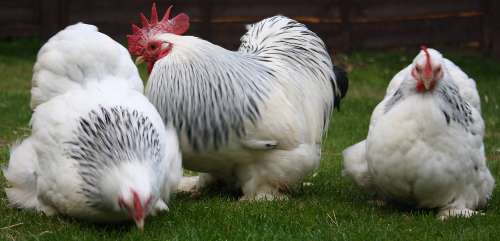
Saddle pearl-white. Tail feathers and tail converts glossy green-black, the covert laced or not with white. Primaries black, or black edged with white; secondaries black on inner edge, white outer. Remainder of plumage entirely white, of pearl-grey shade, free from ticking. Under colour either slate, blue-white or white.
The Colombian colour pattern of the Pekin bantam is the same as the light Sussex fowl is black on white.
Coronation Pekin Bantams:
It still follows the same principles; a coronation bird must have both parents with the gene. Coronation colour is stunning. Faults include brassiness in the white amongst others.
Below: A coronation pattern Pekin bantam hen.
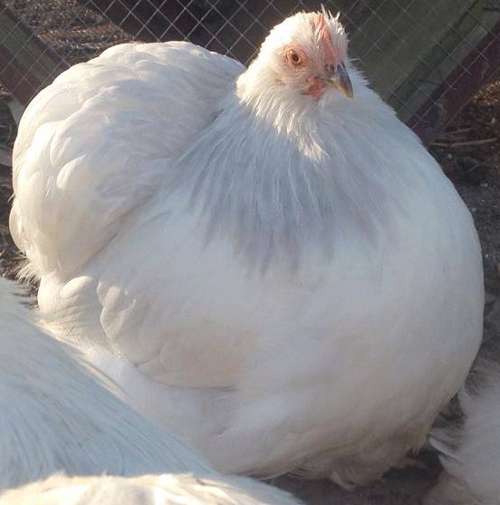
Below: Coronation pattern Pekin bantam cockerel.
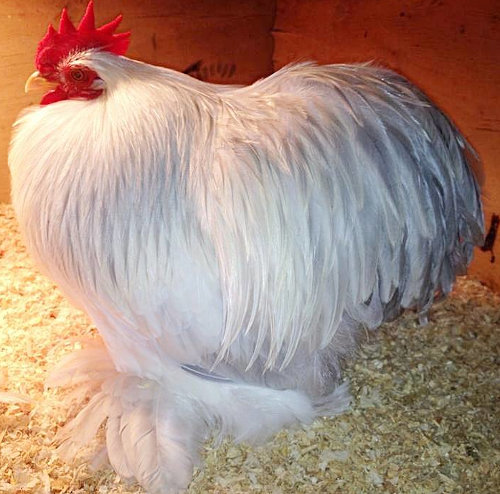
With the coronation pattern it is similar genetics to the Colombian but instead of black they have lavender.
Silver Laced Pekin :
Below: Silver laced Pekin day old chicks.
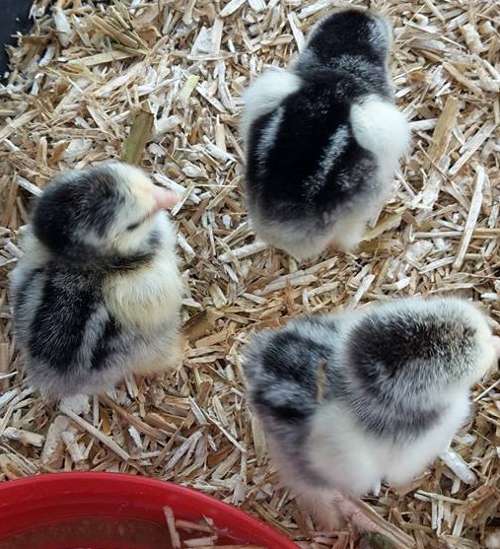
Female plumage: Hackle black centre with white edges, a little rust permissible. Breast white, slightly peppered, outside edge black. Wing primaries black inside, white outside, slightly peppered; secondaries well peppered.
Below: A Silver laced Pekin hen.
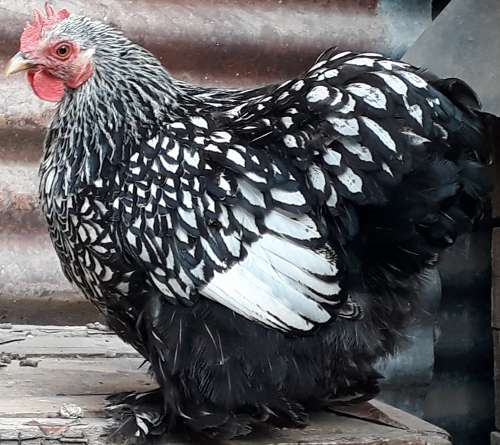
Male plumage: Hackle silver with black centres. Breast silver with black edging. Back and saddle black centre with white edges. Under colour is silver-grey. Wing primaries black; secondaries black edged with white. Tail black with beetle-green sheen; sickles edged with white.
Below: A silver laced Pekin cockerel.
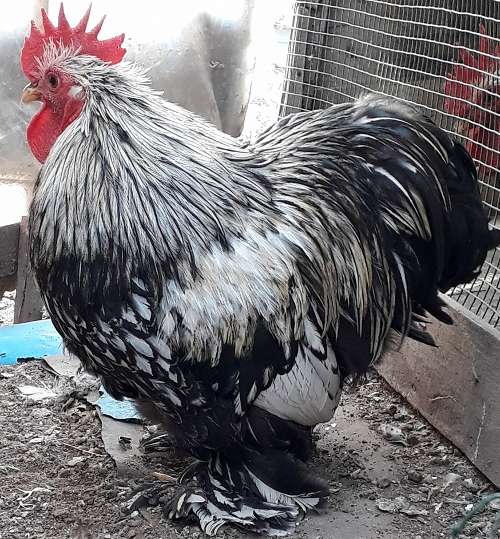
Gold Laced Pekin Bantams:
Below: A gold laced Pekin hen.
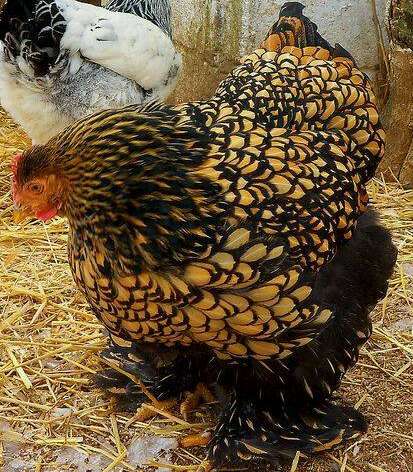
The description is the same as the silver laced just with the gold ground colour.
Millefluer Pekins:
The literal translation of Mille Fleur is "thousand flowers."
Below: Millefleur Male with an even ground colour and each feather should have a black pea shaped end tipped with a white point.

Mille fleur bantams boast a base feathering of deep brown, with each feather containing a black crescent pattern with a silver tip.
Below: Millefleur Pekin hens. Notice the difference in feathers.
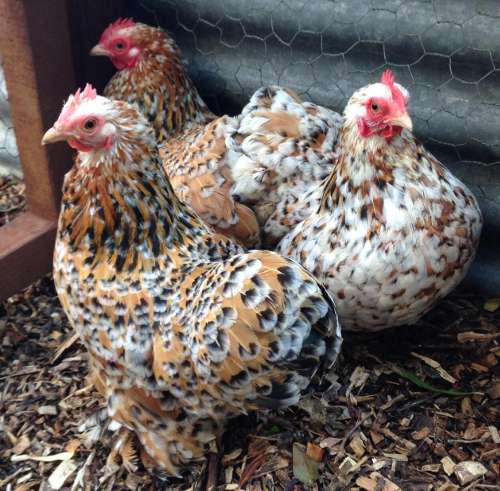
The Mille Fleur pattern consists of a ground colour of mahogany. Each feather is marked with a crescent shaped bar of black and tipped with a V-shaped white spangle.
The true colouring does not usually appear until the first adult moult.
Splash feathered Pekins:
The genes for "blue" are not dominant and dilute the black. Two copies of the gene result in "splash" plumage. In chickens, splash is a very light colour, pale grey or white with "splashes" of black and darker grey in the feathers.
Below: A Splash Pekin Cockerel.
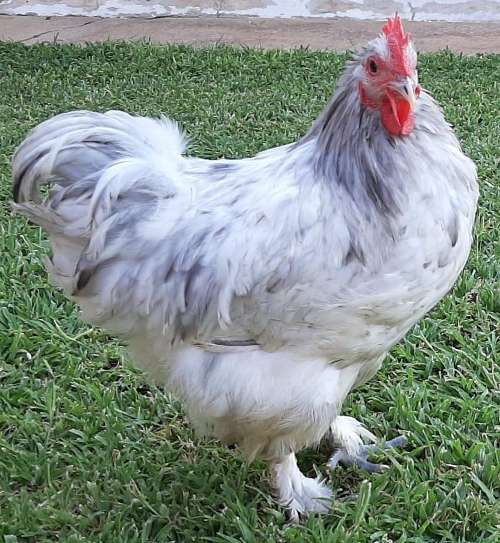
Below: A splash Pekin hen.

Porcelain Pekin chickens:
The porcelain plumage is a light beige or straw colour with slate blue stripes & white highlights.
Below: A porcelain cockerel.
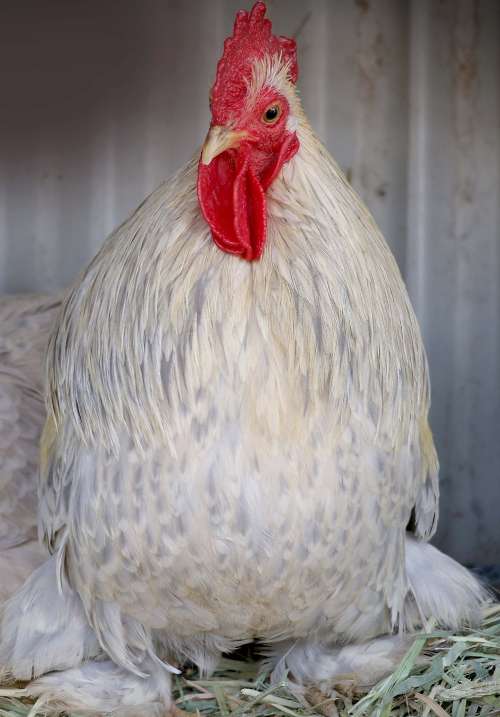
Below: A porcelain hen.

Chocolate Pekins:
Chocolate feathering is a rare Sex-Linked Recessive gene that is basically a dilution of black pigment and has a tendency to breed back to black if not careful.
Chocolate genetics are complex, the hen has one copy and the cockerel has two. It also happens that a black male may be carrying a copy of the chocolate that can be passed to his offspring.
Below: A chocolate grower.

- Chocolate Male X Chocolate Female = 100% Chocolate
- Black Male X Chocolate Female = 50% Black Males carrying Chocolate, 50% Black Females
- Chocolate Male X Black Female = 50% Black Males carrying Chocolate, 50% Chocolate Females
- Black Male carrying Chocolate X Chocolate Female = 25% Chocolate Males, 25% Black Males carrying Chocolate, 25% Chocolate Females, 25% Black Females
- Black Male carrying Chocolate X Black Female = 25% Black Males carrying Chocolate, 25% Black Males, 25% Chocolate Females, 25% Black Females.
Below: A chocolate Pekin hen.
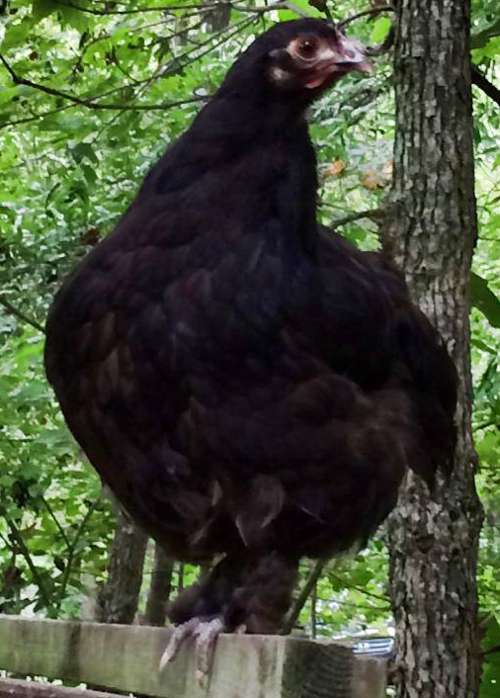
Wheaton Pekins:
Below: A Wheaton Pekin cockerel.
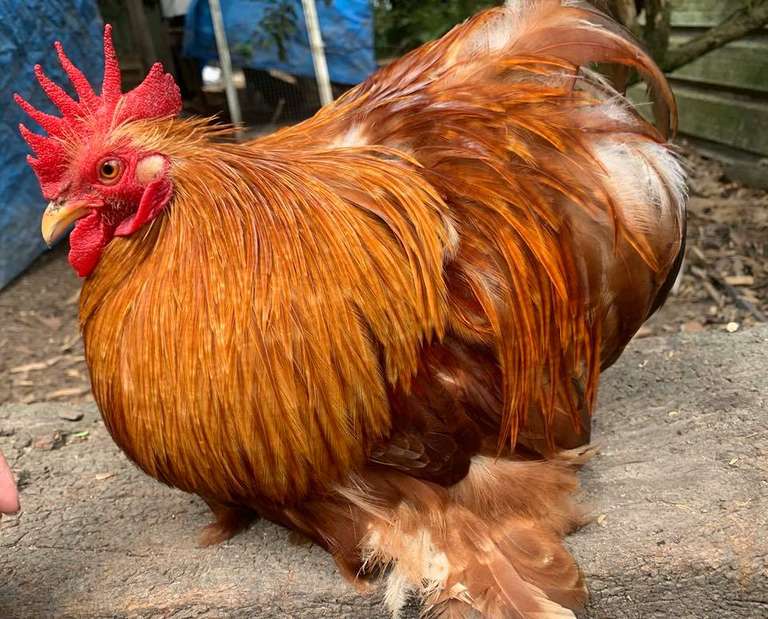
Below: Wheaton Pekin hens.
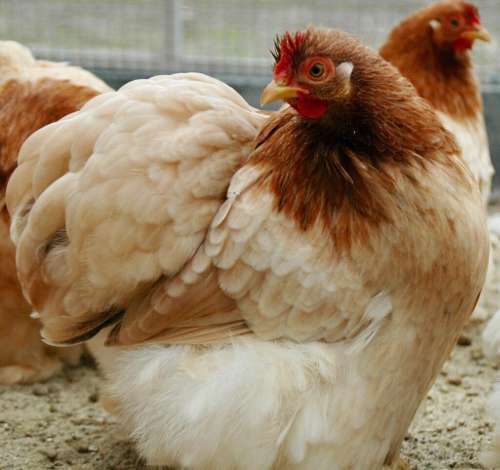
Salmon pekins:
Below: A Salmon pekin cockerel.

Below: A Salmon Pekin hen.
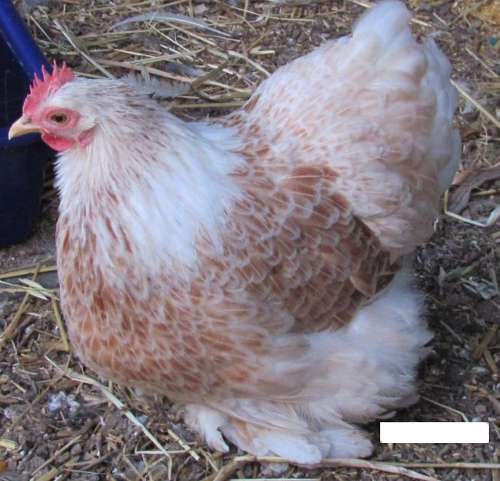
Frizzle feathered pekins:
The Frizzle is a breed of chicken with characteristic curled or frizzled plumage courtesy of the incompletely dominant frizzle gene . While the frizzle gene can be seen in many breeds, such as the Pekin and Polish, the Frizzle is recognised as a distinct breed in a number of European countries and Australia.
Below: A Frizzle.

Below: A frizzled Serama bantam.
